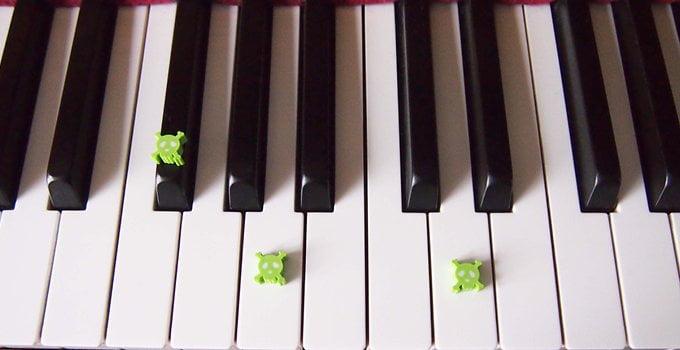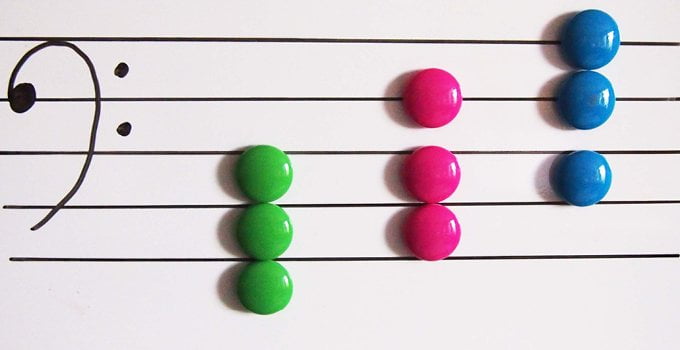This post about teaching piano chord inversions was originally published in October 2017, and updated in March 2020.
How were YOU taught about piano chord inversions? Can you think back to the way they were first introduced to you? I have several students right now who have been working towards their Chord Apprentice challenge, and they’re almost ready to think about inversions.
I don’t like to delay this introduction too long. Chord inversions are extremely useful and students need them to play fluently from lead sheets and recognise chord patterns in their repertoire.
But…they can be confusing.

I remember being boggled by them as a student. I got the general idea, but when I tried to think about what chord I was looking at my brain would just freeze. It seriously felt like I could barely even recognise the notes anymore…my mind simply went into panic mode.
I certainly don’t want my students to feel that mental block when it comes to learning chord inversions. So, I’m being proactive and introducing them as early as I can, in very small doses at first.
Here’s the three-pronged approach I take to teach piano chord inversions to my early intermediate students.

Subscribe to updates and get the chord inversion cheatsheet
Enter your details to subscribe to the newsletter for piano teachers with information, tips and offers.
I hate spam as much as you do! I'll only send you information that's directly relevant to music teachers and you can unsubscribe at any time.
Psst…Vibrant Music Teaching members can access this resource instantly inside the VMT library. Not a member yet? Find out more about becoming a member here.
Step 1: Keyboard Mapping
First I introduce inversions right on the piano. I think this makes it clearer for students than it ever could be on the staff.
If you’ve been following this blog for a while, it won’t be a surprise to you that I immediately reached for some colourful erasers for this task.

These erasers are little skulls that I picked up in Blick Art Materials in San Francisco one summer. Perfect size for the piano keys!
Using small tokens on the keys like this makes teaching chord inversions pretty straightforward. I explain how we can take the bottom note and put it on top each time to create the new inversion.
Then once my students get the idea we do lots of drilling. I ask them to create various chords on the piano, and then to identify chords that I create.
I keep going with this until my students are almost instantly placing and naming the chord inversions.
Step 2: Staff Mapping
Then, and only then, we take a look at the chord shapes on the staff.
I wanted a way to make this transition smoother for my students. In the past I’ve used flashcards, but I felt I needed an in-between step that was more hands-on.
Which is why I’m now using my magnetic white board to first introduce the chord inversions on the staff.

This works great because, just like the keyboard mapping above, students can physically move the notes up to the top of the chord to make the inversion.
Then we just repeat, and repeat, and repeat some more until this becomes almost boringly easy for my students.
Step 3: Mental Respelling
Now it’s time to see the chord inversions out in the wild.
When we’re trying to identify what chord we’re looking at, I encourage my students to “mentally re-spell” the inversions to create the root position chord.
It doesn’t matter if we’re looking at a staff or the shape on the keys – the idea is to move the notes around in your head until they’re as close together as possible.
(Side note: I’m only talking about triads here. I believe in getting these really secure before really going in-depth on the madness of sevenths and ninths and other craziness. Keep it simple to start – you can get fancy later.)
This imaginary reorganisation does still take some practice, but it’s a helluva lot easier than it would’ve been if we skipped those first two introductory steps.
Bonus Step 4: Ready, Set, Gamify!
I think our students deserve some giggles after all that hard work, don’t you?
My kiddos love practising their new chord knowledge with the wonderfully frantic Inversions Diversions game, which VMT members can grab from the VMT library.
Not a member yet? You won’t believe what you’re missing out on!

How do you teach chord inversions?
I’m always open to new ideas and ways of looking at things. Write your favourite chord inversion teaching ideas in the comments or in the Vibrant Music Studio Teachers group on Facebook. And if you want to learn more about teaching piano chords, visit my Music Theory page.
Love these ideas! Where do you get the magnetic board and markers? I have a magnetic white board ( a big wall one, like a chalkboard) but can’t find the right size magnets.
Hi Mary! My magnetic whiteboard is from ikea and the little round magnets are from my local office supply store (these ones are similar, just a little bigger: https://www.amazon.com/Large-Assorted-Notice-Planning-Magnets/dp/B007JTNW6E/ref=sr_1_8?s=home-garden&ie=UTF8&qid=1508076976&sr=1-8&keywords=notice+board+magnet). I just drew the staff to match their size. 🙂
I entered my info to get the chord inversion cheat sheet but a different handout about transfer students showed up in my email.
Oopsie daisies! Fixed now Krista!
Super ideas ! Love it !
nice thanks
Hey, I’m jerry wizzy, a student of English literature at Massachusetts university currently working as a designer at brown gap hoodie. BGH is an international online shopping store where you can buy a hoodie. they have a massive collection of hoodies for you.